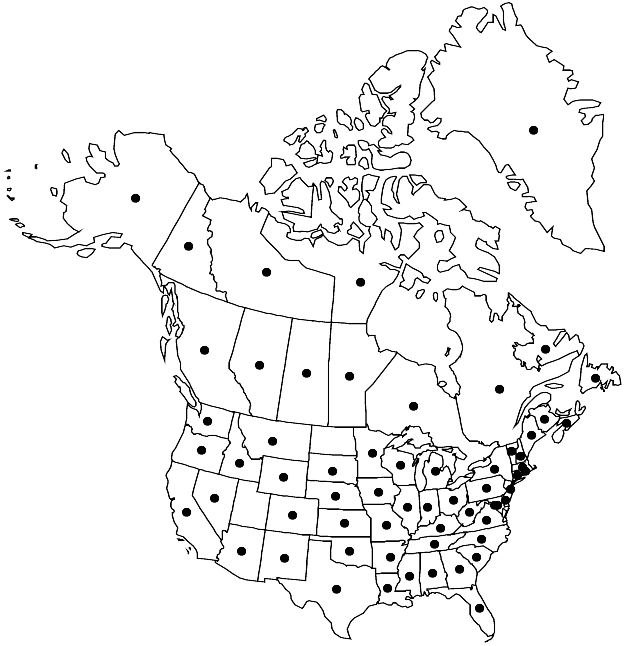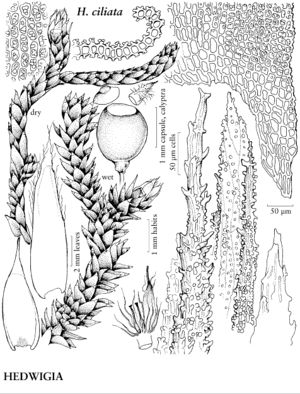Difference between revisions of "Hedwigia ciliata"
Prodr. Aethéogam., 15. 1805.
FNA>Volume Importer |
imported>Volume Importer |
||
| (2 intermediate revisions by 2 users not shown) | |||
| Line 61: | Line 61: | ||
|publication year=1805 | |publication year=1805 | ||
|special status=Illustrated | |special status=Illustrated | ||
| − | |source xml=https:// | + | |source xml=https://bitbucket.org/aafc-mbb/fna-data-curation/src/2e0870ddd59836b60bcf96646a41e87ea5a5943a/coarse_grained_fna_xml/V28/V28_133.xml |
|genus=Hedwigia | |genus=Hedwigia | ||
|species=Hedwigia ciliata | |species=Hedwigia ciliata | ||
Latest revision as of 21:34, 5 November 2020
Leaves 1.5–3 mm; margins broadly recurved to 1/3 leaf length, narrowly recurved to apex on one or both sides, or plane mid leaf and plane, erect, and/or incurved in acumen on same plant, teeth in apex broad, irregularly papillose to smooth; apex erect, erect-spreading, or often secund when dry, broad and hyaline, muticous, or acuminate with acumen narrow-based, 1/10–1/5 leaf length, broadly or narrowly, shallowly or deeply channeled, extreme apex flat; medial and distal laminal cells with papillae (1–)2(–4), small, simple, sessile, or low-stalked, variously branched; laminal cells in hyaline area with papillae low, simple, in linear rows throughout or sparsely to coarsely and irregularly papillose proximally and smooth to minutely rounded-papillose distally; apical cell short-rhomboidal, obtuse to truncate, (40–)50–75(–80) µm, multipapillose-coronate. Perichaetia with leaves plane, margins long-ciliate distally. Vaginula sparsely to densely pilose. Calyptra naked, sparsely pilose proximally, or densely pilose throughout.
Phenology: Capsules mature spring–late spring.
Habitat: Dry rock, acidic rock (granite, sedimentary), conglomerates, limestone, soil, cliffs, dry, sunny boulders, in woods on acidic glacial erratic rock, tree trunks and branches, asphalt shingles, edges of asphalt roads
Elevation: low to high elevations (0-2300 m)
Distribution

Greenland, Alta., B.C., Man., N.B., Nfld. and Labr., N.W.T., N.S., Nunavut, Ont., Que., Sask., Yukon, Ala., Alaska, Ariz., Ark., Calif., Colo., Conn., Del., D.C., Fla., Ga., Idaho, Ill., Ind., Iowa, Kans., Ky., La., Maine, Md., Mass., Mich., Minn., Miss., Mo., Mont., Nebr., Nev., N.H., N.J., N.Mex., N.Y., N.C., Ohio, Okla., Oreg., Pa., R.I., S.C., S.Dak., Tenn., Tex., Vt., Va., Wash., W.Va., Wis., Wyo., Mexico, West Indies, Central America, South America, Eurasia, Africa, Atlantic Islands, Pacific Islands (New Zealand), Australia.
Discussion
In plants of Hedwigia ciliata with dense paraphyses extending onto the calyptra, the paraphyses are sparsely papillose and have sharp lateral teeth on one side at the distal ends of some cells. In the eastern to northeastern part of the flora area, the typical facies have vaginula and calyptra that are densely pilose. The hyaline apices are absent to short or to 1/3 the leaf length.
Although the type of Hedwigia ciliata var. leucophaea has apparently been lost, L. Hedenäs (1994) gave formal synonymy for var. leucophaea. W. R. Buck and D. H. Norris (1996) proposed the name H. nivalis for a facies of what was formerly called H. ciliata in the southwestern United States, and for all tropical American material. B. H. Allen (2010) accepted this suggestion. M. Lueth and A. Schaefer-Verwimp (2004) reported var. leucophaea as new to South America and that the two specimens of the variety were collected from the type locality of H. nivalis. The leaves in var. leucophaea are more oblong (less ovate) than in H. nivalis, the acumina are narrower, and the calyptra is pilose. These characters in the flora area are present and variable throughout the range of H. ciliata, especially in areas west of mid-continent.
Selected References
None.
